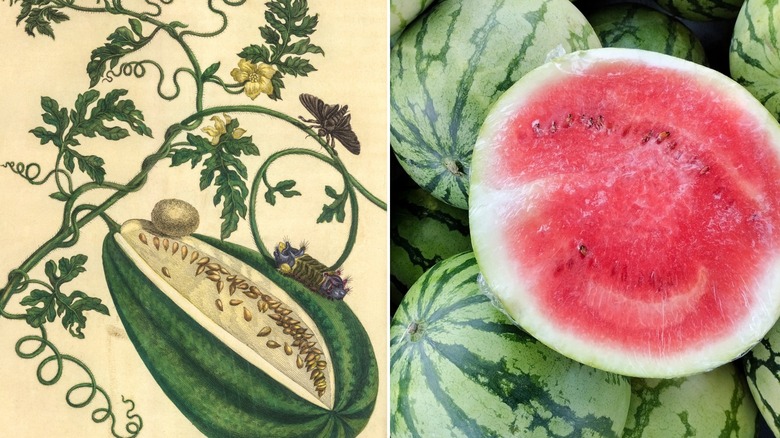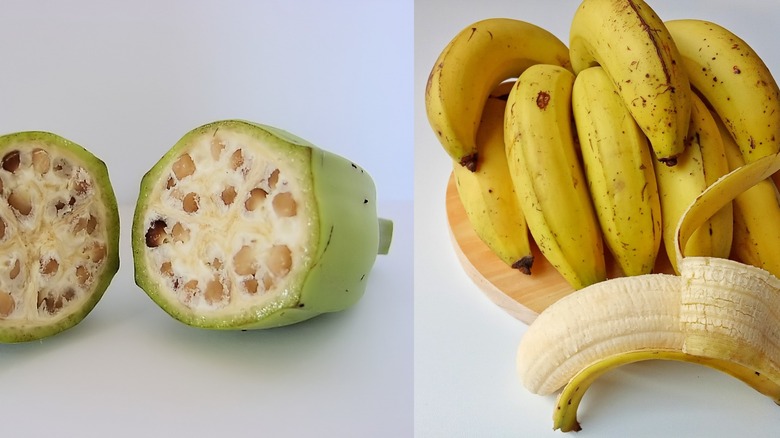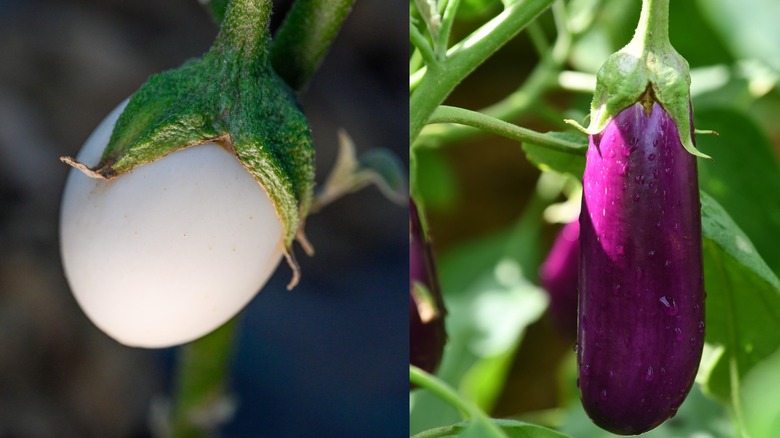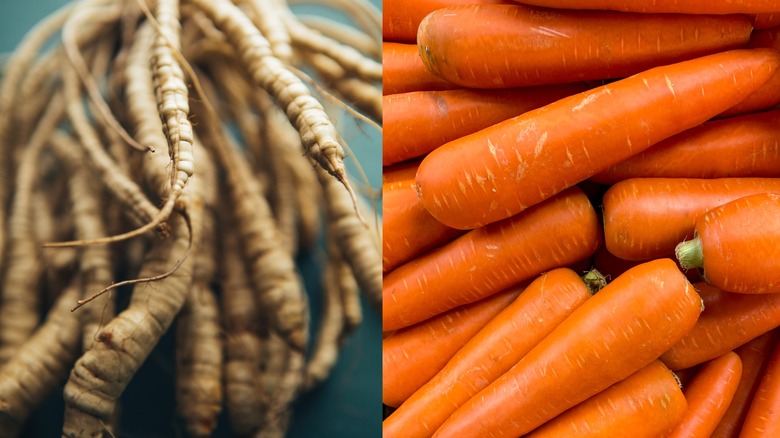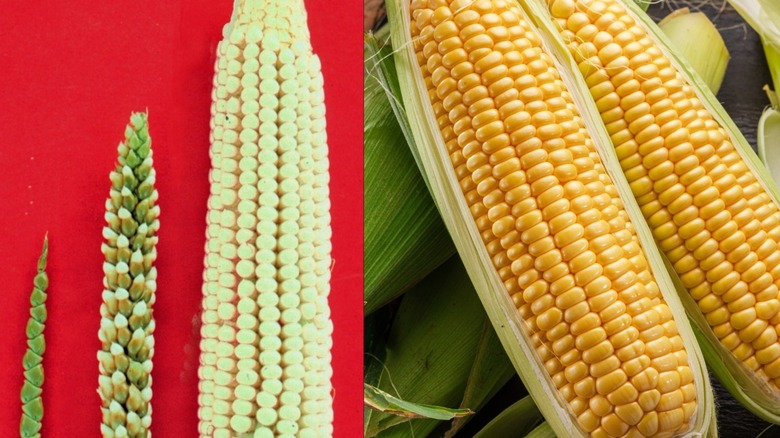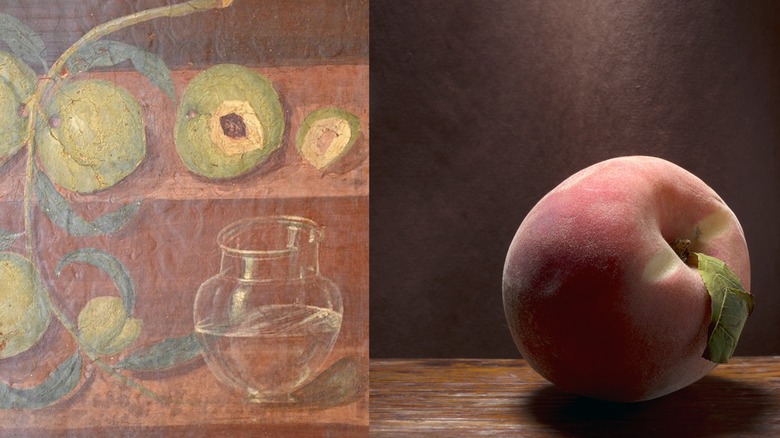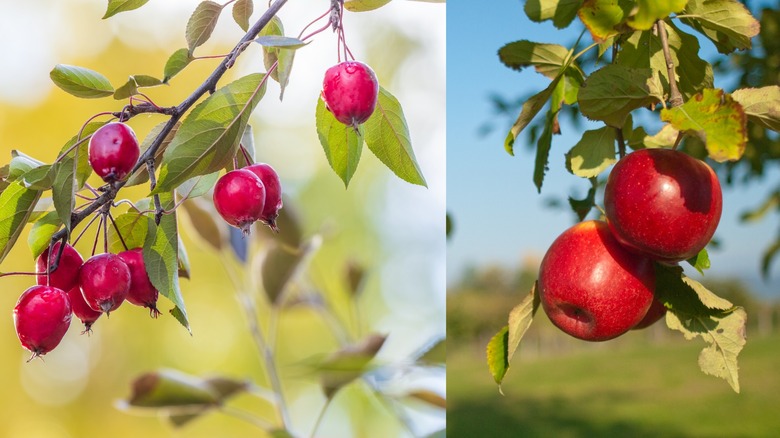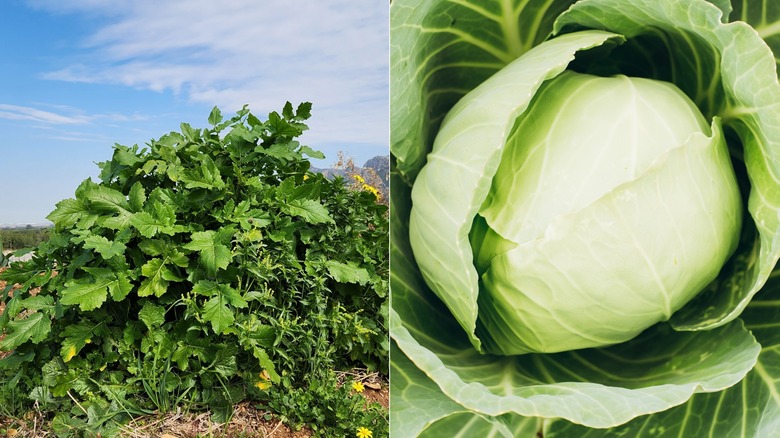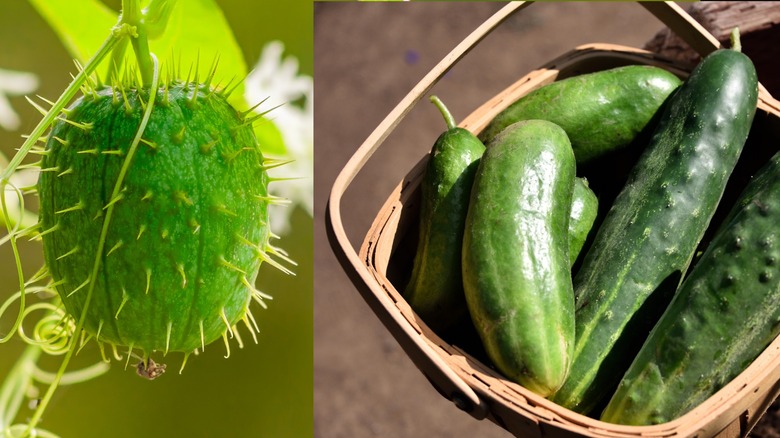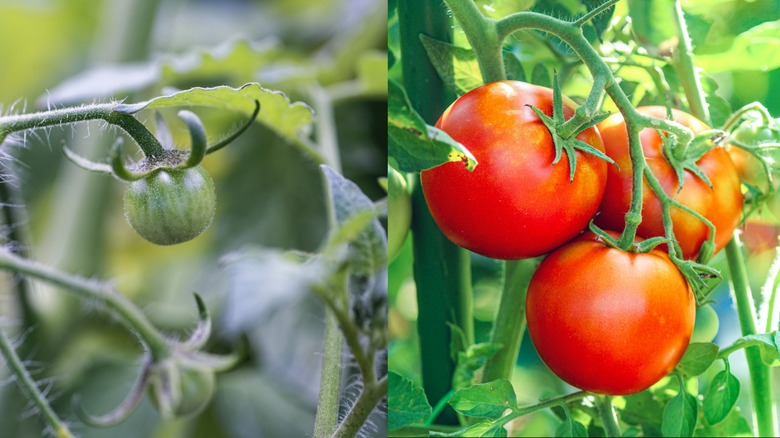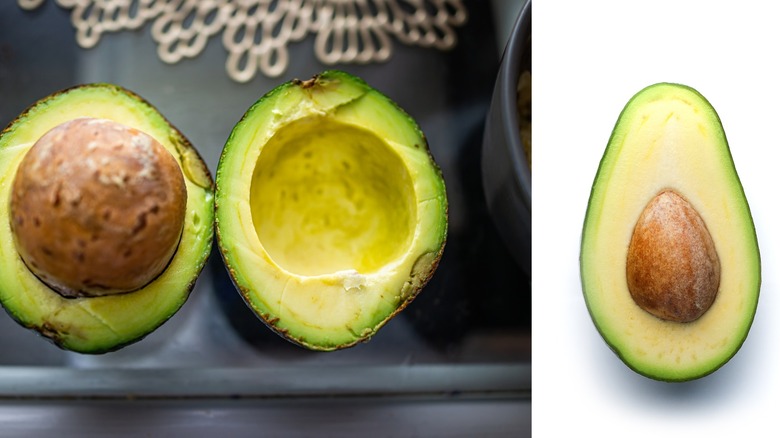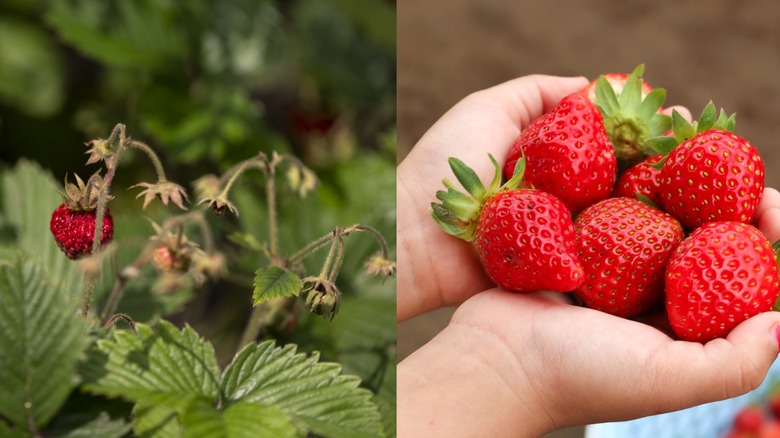Fruits And Vegetables That Look Nothing Like They Used To
When you walk through the produce aisle, you may come across just a few fruits or vegetables that aren't entirely familiar. You may know what they are, but you might not know how to use them or even what far away place the chain shipped them in from. After all, if you live in the United States, it's unlikely that your farm or orchard down the road is growing rambutan (different from lychee) or durian fruit. However, most of the fruits and veggies on display are pretty recognizable. The pyramids of apples, the crates of cabbages, and the piles of peaches all represent foods you probably became quickly familiar with as a child.
If, though, you were to travel back in time, sometimes even just a hundred years ago, you might find that the fruits and vegetables you thought you knew and loved are entirely unfamiliar. Over the decades and centuries, modern agriculture and cultivation have entirely changed the appearances of certain plants, making for heartier, bigger, better fruits and veggies. Here are some of the most common fruits and vegetables that currently look nothing at all like they used to.
Watermelon
When you slice into a watermelon today, if that melon is perfectly ripe, you're treated to a ruby-red center, minimal rind, and, if you made a careful purchase, no seeds whatsoever. Indulging in the ideal slice of watermelon is a quintessential part of summer — but watermelon wasn't always this eye-catching mix of bright red and green — though they've always tasted pretty good.
Instead, the watermelons of yore boasted a more white-pink center than bright red. Red watermelon flesh gets its coloring from high levels of lycopene (similarly to a tomato). However, the original watermelons that folks were eating in the Middle Ages didn't have that much lycopene and, thus, little in the way of a bright red center. Agricultural breeding has fine-tuned the watermelon to give us the color combo we most associate with the melon today, as well as watermelons without those pesky seeds. No, it's not like breeders were trying to specifically make a red watermelon; instead, they wanted to make a sweeter watermelon — it just so happens when you breed a watermelon to be sweeter, it becomes redder, too.
Bananas
When you're eating a banana, you probably hardly even notice the seeds. Those small, edible, black specks in your breakfast aren't worth a second thought, or even a first. If, though, you were eating a banana, say, 7,000 years ago, you'd probably have a different experience. Then, banana seeds were incredibly large and plentiful. You could almost say the banana was more seed than flesh. Over time, bananas were cultivated to have a more palatable flesh-to-seed ratio, as well as a more palatable flavor.
Even if you fast-forward to the mid-1900s, though, bananas weren't quite the same then as they are now. Sure, they may've looked more like a modern banana, but they definitely tasted different. This is because the main banana of the day was the Gros Michel variety. Now, the variety of choice is the Cavendish. In comparison, the Gros Michel banana is firmer and creamier, with a lingering flavor. Want to try a Gros Michel banana? They're incredibly difficult to find today, so pick up some banana-flavored candy instead. Commercial banana flavoring, developed in the 20th century, was based on the Gros Michel banana.
Eggplants
Nothing in the produce world looks like an eggplant or, if you prefer, an aubergine. It's so recognizable it has its own emoji. The almost tubular, purple produce can be found used in cuisines across the world. However, have you ever wondered why the eggplant is called an eggplant? What's the "egg" connection?
The answer goes back to the plants' prior appearance. Centuries ago, the average eggplant plant grew fruits that looked more or less like an egg. They were smaller than today's eggplants, round rather than oblong, and white. At this time, at least in Europe and the United States, eggplants were considered ornamental rather than edible. Today, you can still grow, buy, and eat white eggplants that look and taste like these earlier eggplants. However, they're not at all what anyone imagines when thinking of an eggplant. The modern eggplant is a variety introduced to the Western world by Asian and Middle Eastern immigrants, and which eventually became more popular than the white, smaller eggplants.
Carrots
Long, slender, bright orange — the classic carrot is every bit as recognizable as today's purple, oblong eggplant. However, the OG carrots were spindly and white, more thick plant root than scrumptious vegetable. In fact, in the earliest instances of carrot cultivation, it wasn't even the roots that cultivators were after; instead, carrots were prized for their seeds, flowers, and leaves. The root portion of wild, uncultivated carrots isn't exactly delicious. However, eventually, cultivators caught on to the fact that cultivated carrots were pretty tasty, and the food grew in popularity.
Originally, cultivated carrots were mostly purple or yellow, with orange and red carrots available to lesser degrees. Orange carrots specifically were developed in the Netherlands in the 1600s and, as orange carrots were found to by and large offer more nutrients, as well as a more widely popular taste, the orange carrot took over and became what we think of as a typical carrot today.
Corn
Ancient corn really doesn't look like something you'd want or even could eat. The earliest corn ancestor is a Mexican plant known as teosinte. While the plant looks pretty similar to a stalk of corn — albeit much smaller — what the plant produces does not look anything like an ear of corn. Instead of rows of plump corn kernels packed tightly onto a thick cob, these ancient plants produced no cob at all, and shells containing just a few kernels each. Instead of a cob, the kernels attached to a stem that was a few inches long. The kernels? About the size of a peppercorn.
So how did we get from this tiny maize to today's corn? Scientists estimate that, approximately 10,000 years ago, cultivation began that slowly morphed teosinte into corn. The shells that previously covered the kernels began exposing the kernels. Eventually, the shells retreated to the point that they formed a cob. Over time, cultivation efforts resulted in plants with more and larger kernels.
Peaches
The differences between ancient and modern peaches are pretty similar to the differences between ancient and modern watermelon. Thousands of years ago, peaches were small — dramatically so. Think maybe a fourth or fifth the size of a peach today. They also weren't, well, a peach hue. Instead, they were kind of green-white. They also didn't taste as sweet as peaches do today. Wild peaches' skin was thin, and the fruit was tough. As was the case with wild bananas, wild peaches featured a larger pit in relation to the fruit, for less edible flesh overall.
Peach domestication began approximately 7,500 years ago, in China. Fun fact: China is the largest peach producer in the world, producing about 70% of the world's peaches, or millions of tons of the fruit per year, per the USDA. The fruit spread from Asia, into Europe, and eventually to North America via Spaniards, who introduced the fruit to Indigenous populations. Cultivation continued, with farmers breeding fruit for sweetness, size, and a greater level of firmness that would make for easier peach transportation.
Apples
Apples have long been intertwined with human history. If you believe such things, a bad apple got humanity kicked out of the Garden of Eden. In terms of historically proven connections with apples, it's been found that wild apples were carried along the Silk Road, and those wild apples mixed and mingled to create the forefathers of today's modern apples. Fast-forward a bit and, in the 1500s, Europeans brought apples to the Americas. Those apples, though, might be easier likened to crabapples than a Granny Smith or Gala. They were smaller than today's apples, and incredibly sour, much more than your average Granny Smith. They weren't great for eating straight-up, but they were decent for making cider.
Even in the late 1800s, most of the apples grown in the United States were still being used for cider. However, in the early 1900s, the demand for cider decreased significantly, thanks to Prohibition. Orchards had to shift to selling their wares another way, and the varieties of apples best for eating, cooking, and shipping cross-country became the most in-demand — leading to greater cultivation that resulted in the varieties of apples we have today.
Cabbage
Want to see what cabbage originally looked like? You might be able to find some growing out in the wild, if you live in the right spot. All modern cabbages are descended from one plant: Brassica oleracea. This plant is more commonly known as wild mustard.
The Ancient Greeks and Romans domesticated the plant first and, as farmers are ought to do, they began specifically cultivating their plants based on desirable features. This eventually led to wild mustard turning into not just the modern cabbage, but actually six different vegetables that we eat today and that all look very different from one another: cabbage, Brussels sprouts, kohlrabi, kale, broccoli, and cauliflower. Wild mustard plants that were cultivated to produce bigger and more leaves turned into kale. Wild mustard plants cultivated to produce large leaf buds became cabbage. Farmers who wanted plants with bigger flowers? They got cauliflower and broccoli. Meanwhile, those who wanted bigger stems ended up with kohlrabi, and those who wanted lots of small heads eventually ended up with Brussels sprouts.
Cucumbers
Don't make the mistake of thinking that just because wild cucumbers gave birth (albeit, over a few thousand years of cultivation) to the modern cucumber, that you can go out and find a wild cucumber and give it a taste. The wild cucumber is an oval shape rather than long and skinny, and covered in spines, so you'll have a difficult time getting into the flesh. Additionally and more importantly, wild cucumbers are toxic.
You'd have to travel quite a far ways back in time to find a human eating a cucumber that looks unfamiliar, though. Cucumbers have been farmed for food for thousands of years. That said, ancient cucumbers would have probably tasted slightly unpleasant by modern standards. It hasn't been until recent history that breeders have managed to reduce or eliminate cucumbers' natural bitterness. Still, that didn't stop Ancient Egyptians and Greeks from eating this vegetable. In fact, Egyptians were known to craft cucumber liquor by harvesting cucumbers, inserting a stick into a hole in the cucumber's skin, stirring up the insides, and then burying the cucumber until the interior mixture fermented.
Grapes
Like cucumbers, grapes have been grown and enjoyed for thousands of years and, while we may not regularly sip the cucumber liquor crafted by the Ancient Egyptians, we still very much indulge in the same wine that our ancestors might've (even though the flavor profiles are likely quite different). Before we began growing grapes, though, somewhere around 6,500 B.C.E., grapes grew wild.
Wild-growing grapes grow just like any vining plant might. Vines twist and grow whichever way they can in order to get sunlight and similar resources, with thin tendrils stretching in all directions — a far cry from the seemingly thick and sturdy vines lined up in neat and orderly rows at a vineyard. Additionally, modern grapes have been fine-tuned via breeding to produce as many grapes as possible; in contrast, wild grapes produce less overall grapes per bunch. Wild-growing grapes likewise don't have the flavor profile necessary for good wine or good snacking. The native, wild-growing grapes discovered in North America during European colonization were known to be acidic and low in sugar.
Plums
It's estimated that plums were one of the very first fruits that humans domesticated, with the very earliest domesticated plums recorded in China around 470 B.C.E. From there, domesticated plums spread throughout Asia and to Europe. By the time of the Roman Empire, hundreds of European plums alone existed. In the 1600s, plums hitched a ride to the Americas with some very famous passengers: the pilgrims.
Even as plums were cultivated throughout the ages, though, wild plums still had their benefits. Unlike many wild fruits and vegetables from ancient times, which have proven less desirable than their modern-day counterparts, even as early as the 1800s, horticulturalists were catching onto the fact that wild plums were superior to the domesticated varieties in myriad ways, including taste. The trees were also considered more resilient. Today, wild plums can be foraged and eaten fresh or used anywhere you might a domestic plum.
Tomatoes
Early tomatoes were much smaller than your home garden varieties today. The historic standard was closer to a modern cherry tomato in size, and more likely to be yellow or green than red, as well as somewhat sour. Tomatoes were originally grown in South America, where they were first cultivated. Spanish invaders brought the plants from Latin America to Europe, where an interesting theory developed: Tomatoes were poisonous. The truth? While some Europeans did die after eating tomatoes, it wasn't the tomatoes' fault. Instead, these Europeans would often eat their tomatoes on pewter dishes. When the tomato acid interacted with the pewter, it exposed the diners to lead, resulting in death by lead poisoning.
Tomatoes were mostly kept as ornamental plants for a great length of time following their discovery by the Europeans. Give it a hundred or so years, though, and poor populations throughout Europe began eating tomatoes out of necessity, and, finally, in the 1800s, Americans came around to the idea of growing and eating tomatoes, too.
Avocado
If you were to unwittingly buy an ancient avocado at the grocery store, take it home, and cut it open once you deemed it ripe enough, you'd probably be pretty disappointed, maybe even a little mad. Ancient avocados were mostly pit, with very little flesh. However, humans quickly stepped in and began cultivating avocados to make them more appetizing for consumption. Research has found that humans began cultivating avocado trees about 7,500 years ago, but were eating the wild avocados as far back as 11,000 years ago. As cultivation continued, avocados' rinds became thicker, ensuring the fruit was protected while it grew, and the amount of flesh on each avocado also increased.
While ancient cultures may've eaten avocados thousands of years ago, though, modern Americans weren't quick to jump on the idea. While avocado may seem to be everywhere these days, from your game day guac to your brunch avocado toast, avocados didn't really start to gain popularity among mainstream Americans into the 1990s, after an effort to teach the general public about how to use and eat them.
Strawberries
Humans have been eating wild strawberries for thousands of years, but those ancient, wild strawberries were far different from the strawberries you might buy in the store. If you've never seen strawberries in the wild before, they're very small — think about the size of your fingernail, if that — usually a darker shade of red, and they can be tough and not as sweet as domesticated strawberries.
Like many historic fruits and vegetables, strawberry plants were used as ornamental plants in ancient civilizations. However, strawberry cultivation in Europe caught on around the 1300s. It wasn't until the 1700s, though, that cultivators began to grow strawberries that could compete with the modern-day equivalent in terms of size, thanks to the transport of Chilean strawberries to France. Throughout the strawberry's history, cultivation efforts have continued to push for bigger and bigger berries. Today, most strawberries are a mix of the Chilean variety and wild strawberries from Virginia.

